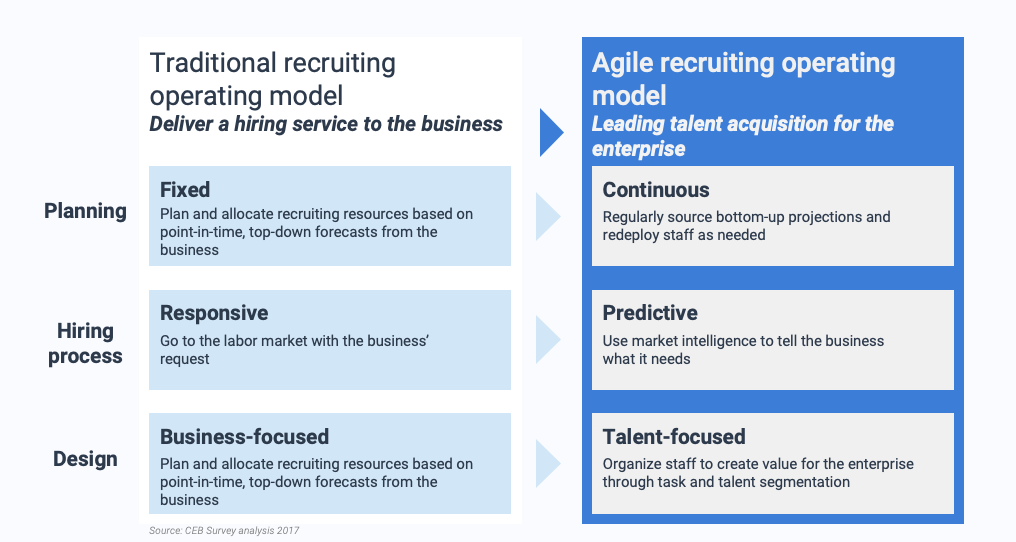Agile Recruiting: Why TA Needs a New Operating Model
88% of business leaders say that acquiring and retaining talent is more important to the business now than it was 12-18 months ago (The Talent Trap).
Talent leaders know that the rulebook is changing, and they are turning to new organizational models, and new ways to structure their teams and their companies, to adapt to this change.
The agile methodology has a lot to offer to the recruiting function: a better way to prioritize hiring projects, improved visibility for both recruiters and hiring managers, the ability to expand and contract as needed to face changing talent needs, and overall, a more efficient, iterative recruiting process.
Why are TA leaders looking at agile recruiting?
There are a few drivers behind this imperative for change and the subsequent search for new ways of working in TA. The most obvious, and the one that is best understood, is the demographic shifts in the global workforce.
For one, COVID-19 has had a huge impact on where people work, and therefore where talent is being sourced from. More and more people are working remotely, opening up new markets for talent and disrupting the status quo. Meanwhile, freelance or gig-type workers are becoming more prevalent, and the way people are approaching work is changing. As a result, TA teams will need to adapt their long-term view of the talent market.
Beyond simple availability of workers, however, we’re seeing a change in the skills that are needed from these workers, as industries are evolving to rely on different core capabilities. Again, the pandemic accelerated the pace of digital transformation, and the technological skills gap that has opened up is one that urgently needs to be closed if businesses are to thrive.
Constant change – and thus innovation – is part of the new normal in the world of work. For companies to stay relevant, every part of the business needs to be able to respond and move quickly: including the Talent Acquisition function. They need a more adaptable operating model to recruit more efficiently, more strategically and more effectively, getting the best people in the right roles quickly.
What agile recruiting can do for TA teams
If candidates are open to, and even asking for, more flexible work formats, how does that change how we hire? Do we have to design a fixed role and hire one person for it, or can we hire a group of people who have a group of skills that can be bundled and unbundled to do a higher number of jobs?
If skills are changing much faster than they did ten years ago, how do we make sure we’re able to advise hiring managers on these changes? Should the process by which we design requisitions start with recruiters instead of hiring managers? Should it be much more consultative and collaborative than it is now?
The reason recruiters are exploring agile operating models is because the agile methodology has good answers to all of these questions. Organizational tools like scrum teams, sprints or kanban boards are only part of it. Agile also means developing a more predictive approach to talent, thinking more in terms of tasks and projects and less in terms of defined roles.

Agile encourages breaking work down into smaller chunks and iterating to solve problems. Companies that have implemented agile operating models properly have found numerous benefits, such as:
- Increased speed and efficiency
- Better quality in the talent pool
- Reduced cost and resources
- Decreased cycle time
- Increased predictability
- Better prioritization
- A better experience for candidates and hiring managers
How to create agility within TA
While a ‘big bang’ approach to agile working, such as that taken by ING Bank in 2015, can create uncertainty, confusion, and even a loss of trust, agility can be introduced to the hiring process through smaller steps. For example, some businesses are using an “internal talent marketplace” format, facilitating talent mobility (people moving roles across the business) to place skills where they are needed on a project by project basis.
The Talent Marketplace allows employees to chart their own career path: technology can match skills they have with open roles, and they can see the options and opportunities open to them, many of which will involve short-term projects that help them upskill or reskill, better understand the business (by working with a different team), and become more engaged and likely to stay.
Agile working needs people who are skilled and engaged, and the agile business needs to fully understand employees’ skills and potential in order to deploy them quickly to the unique challenges each role, project or task presents. Effective, agile talent management is key for making the most of the workforce inside your organization.
Transformation in business in general, and in TA in particular, is inevitable. What will enable enterprises to move ahead in the coming years is whether they are thinking proactively about this transformation, and challenging even the most basic assumptions about how they operate.
For TA leaders, this requires an even deeper shift in thinking: not only do they have to adapt to changes coming from other functions within their organizations, they have to step outside their own function to drive change as well, and push the rest of the company to rethink how it uses talent at the most basic level.
Read more about building an agile workforce..